Janeu (Yagnopaveetham, Upanayana, Janivara) sacred thread information, process, importance, significance, ceremony, procedure, age
Namaste friends, how are you doing today? Welcome to #BhagavanBhakthi website / blog.
Bhagavan Lord Sri Krishna (Vishnu) (Rama) (Trivikrama) and Goddess Sri Lakshmi blessings to you and your family!
In this website / blog, you will always learn about #Hinduism #Sanskrit language.
Also subscribe to my YouTube channel from this link #BhagavanBhakthi to view videos about #Hinduism #Sanskrit language.
Just before going to “Janeu (Yagnopaveetham, Upanayana, Janivara) sacred thread information, process, importance, significance, ceremony, procedure, age“, let us know a brief, basic and very important information.
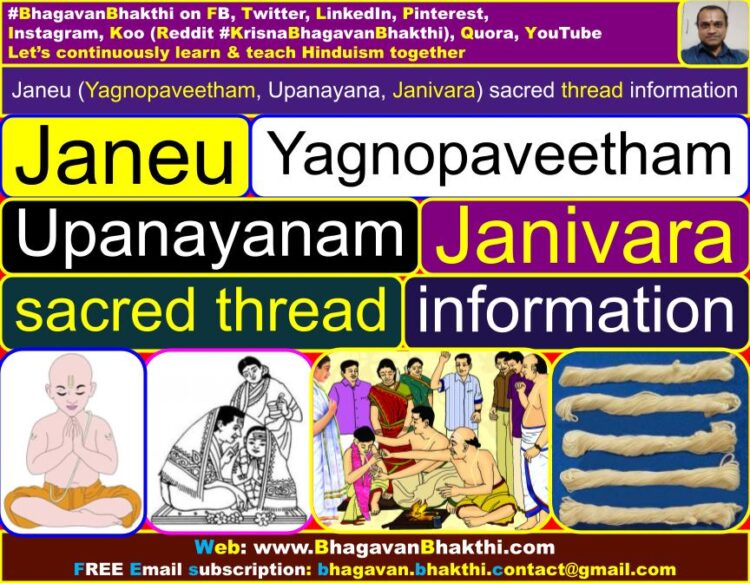
(Note 1: Please remember that Janeu (Hindi) or Janivara (Kannada), Jandhyam (Telugu), Poonal (Tamil) means Yagnopaveetham in Sanskrit.)
(All these words has the same meaning with different pronunciation in different languages. Here we will be using ‘Yagnopaveetham’ as the common word as it is a Sanskrit word.)
(Note 2: Sanskrit words are used in this post, to encourage people understand the correct meaning of that word in the Sanskrit language itself.)
(Likewise, its English translation words are also given side by side for better understanding.)
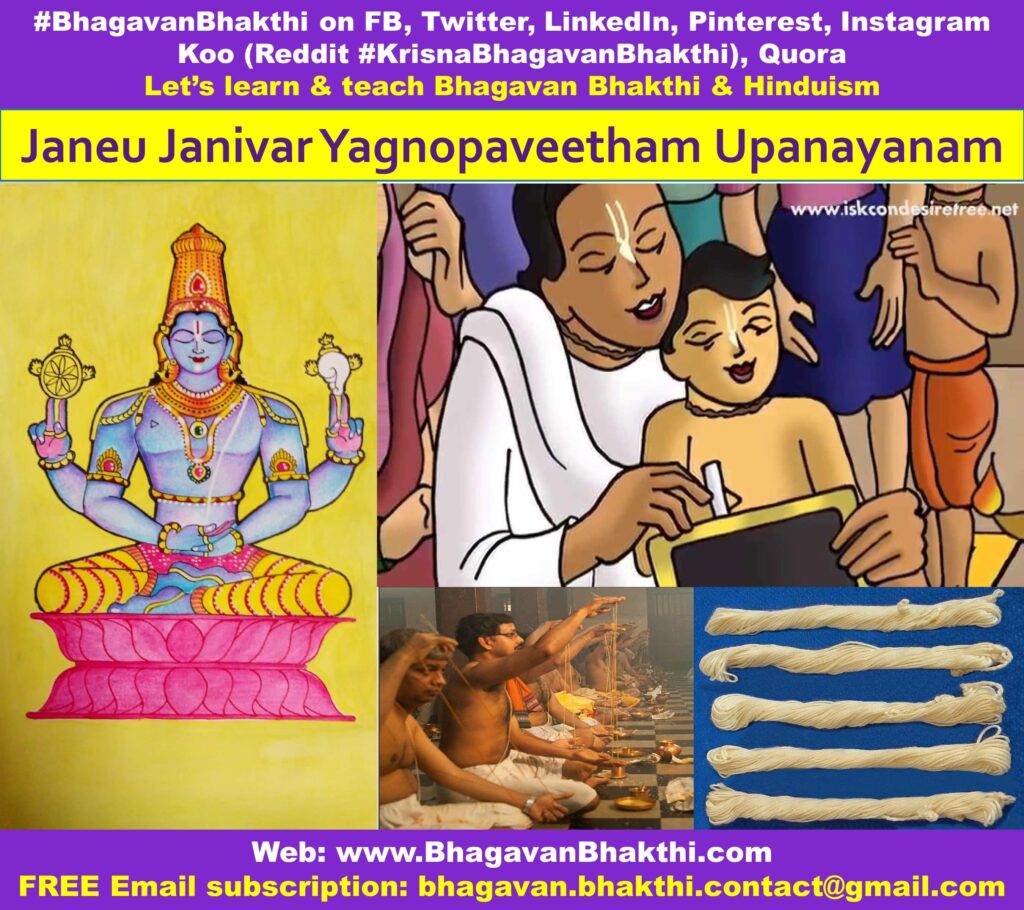
List of Janeu (Yagnopaveetham, Upanayana, Janivara) sacred thread information, process, importance, significance, ceremony, procedure, age, etc. is as given below:
परमं पवित्रं | यज्ञोपवीतं परमं पवित्रं प्रजापतेर्यत्सहजं पुरस्तात् | आयुष्यमग्र्यं प्रतिमुञ्च शुभ्रं यज्ञोपवीतं बलमस्तु तेजः ||
नवभिस्तन्तुभिर्युक्तं त्रिगुणं देवतामयम् | उपवीतं मया दत्तं गृहाण गणनायक ||
ಪರಮಂ ಪವಿತ್ರಂ | ಯಜ್ಞೋಪವೀತಂ ಪರಮಂ ಪವಿತ್ರಂ ಪ್ರಜಾಪತೇರ್ಯತ್ಸಹಜಂ ಪುರಸ್ತಾತ್ | ಆಯುಷ್ಯಮಗ್ರ್ಯಾಂ ಪ್ರತಿಮುಂಚ ಶುಭ್ರಂ ಯಜ್ಞೋಪವೀತಂ ಬಲಮಸ್ತು ತೇಜಃ ||
ನವಭಿಸ್ತಂತುಭಿರ್ಯುಕ್ತಂ ತ್ರಿಗುಣಂ ದೇವತಾಮಯಮ್ | ಉಪವೀತಂ ಮಯಾ ದತ್ತಂ ಗೃಹಣ ಗಣನಾಯಕ ||
Paramaṁ pavitraṁ | yajñōpavītaṁ paramaṁ pavitraṁ prajāpatēryatsahajaṁ purastāt | āyuṣyamagryāṁ pratimun̄ca śubhraṁ yajñōpavītaṁ balamastu tējaḥ ||
navabhistantubhiryuktaṁ triguṇaṁ dēvatāmayam | upavītaṁ mayā dattaṁ gr̥haṇa gaṇanāyaka ||
This shloka explains the important factors like pavitrata / sanctity, adyatmikata / spirituality and shuchitva / sacredness of Janeu (Yagnopaveetham, Upanayana, Janivara) and its benefits.
This shloka says that Yagnopaveetham (Janeu) is “the best among those that purifies the one that has emerged along with the Lord Sri Brahma Deva (First Prajapati) at the time of creation”.
“Yagnopaveetham (Janeu) bestows life and prominence, the one that is sacredly clean and unsoiled, and also the one which confers on to someone who wear both knowledge and power”.
Yagnopaveetham (Janeu or Janivara, etc.) meaning is as given below:
Yagnopaveetham or Janeu is a sacred thread type of thing, in which a triple stranded sacrificial strand of thread are joined by a knot called ‘Brahmagranthi’ that is worn by those initiated into the ‘Gayatri mantra’ recital.
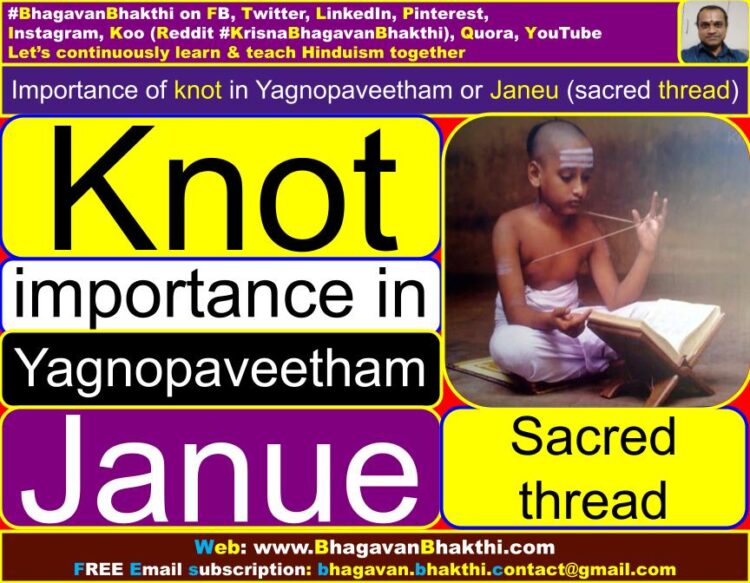
Importance of knot in Yagnopaveetham or Janeu (sacred thread) : Here one single Yagnopaveetham will be having totally nine threads, in which 3 each thread is uniquely separated with a knot. Thus making nine threads with three threads each and with one knot each with three threads.
Yagnopaveetham word meaning : As said above, Yagnopaveetham is a Sanskrit (Samskruta) word. Here, ‘yagna’ means doing homa (a sacred ritual) and ‘upaveetham’ means a covering.
Thus, Yagnopaveetham or Janeu means a sacred covering on the body without which a Yagna (a sacred ritual) cannot be performed.
This means, if someone has to perform any Yagna (a sacrificial ritual), he must have worn this ‘Yagnopaveetham‘ (Janeu) accordingly which is explained in our Shastras (Hindu Texts). In Sanskrit another synonym word for this is known as ‘Brahmasuthram‘.
As said above Yagnopaveetham or Janeu –
In Telugu it is called as Jandhyam, In Tamil it is called as Poonal, In Kannada it is called as Janivara. In English it is called as sacred thread.
‘Yagno-pavita’ or ‘Yagnopaveetham’ means ‘thread of sacrifice’ that symbolizes the sacrifice of ego, anger & selfishness of a human.
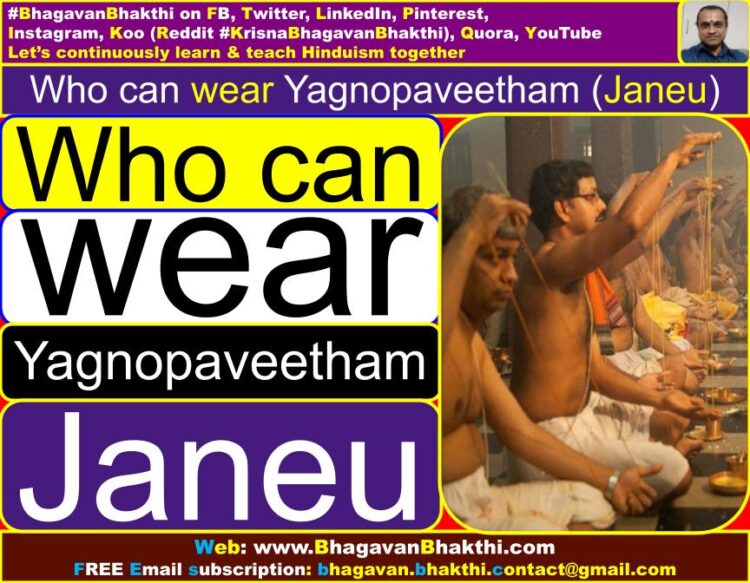
Who can wear Yagnopaveetham (Janeu)? : In earlier Vedic (Vaidika) days both males and females used to wear this sacred thread ‘Yagnopaveetham’.
But since time has changed and Kali Yuga has arrived, in today’s time only males are eligible to wear this with the initiation of ‘Gayatri Mantra’.
Can Kshatriyas, Vaishyas and Shudras wear Yagnopaveetham (Janeu) : When the four Varnas are considered, that is, Brahmanas, Kshatriyas and Vaishyas who is a dvija can wear this sacred thread Yagnopaveetham (Janeu).
All these men should start wearing from the day they are initiated into ‘Gayatri Mantra’ which generally happens through a ceremony called ‘Upanayanam’.
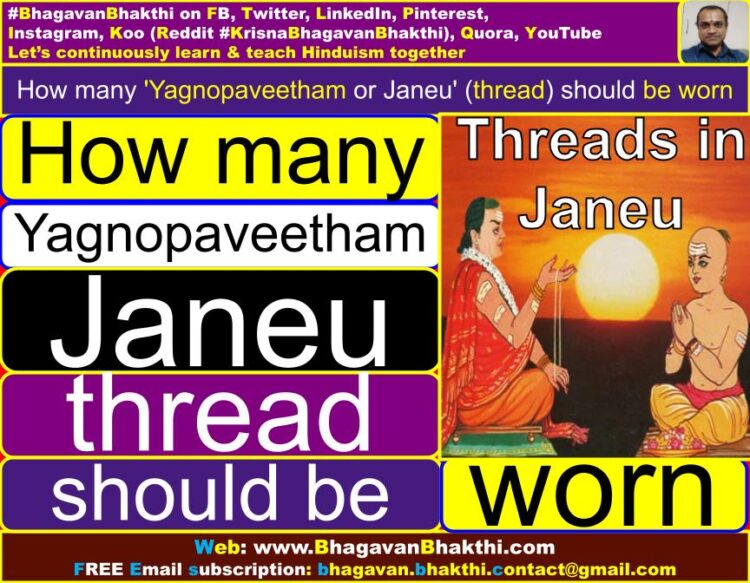
How many ‘Yagnopaveetham or Janeu’ (thread) should be worn : According to Shastras (Hindu Texts), a Brahmachari (unmarried male) should wear only one Yagnopaveetham (Janeu) that has three strands.
A ‘Grihastha’ (married male) should wear two such Yagnopaveetham (Janeu). Nowadays, it is in practice to wear three Yagnopaveetham (Janeu) by a Grihastha (married male) also, the third one that acts as an Uttareeyam (upper dhothi / cloth).
What should be the length of Yagnopaveetham (Janeu) : When we wear a Yagnopaveetham (Janeu), the length of the it should come up to the nabhi / navel level. Yagnopaveetham (Janeu) should be neither above nabhi / navel nor below the nabhi / navel.
Shastras (Hindu Texts) instructs that if it is below the nabhi / navel it will lead to the loss of tapas shakti (penance power) and if it is above the nabhi / navel it will lead to ‘aayuksheenam’ (reduction in lifespan).
The length of the sacred thread used for making Yagnopaveetham (Janeu) as per the scriptures (Hindu Texts) should be 96 breadths of four fingers measured by ones own hand.
Yagnopaveetham (Janeu thickness : Thickness of the sacred thread Yagnopaveetham should be of a mustard seed size.
Nowadays we don’t find such observations being followed in the making of the sacred thread Yagnopaveethams.
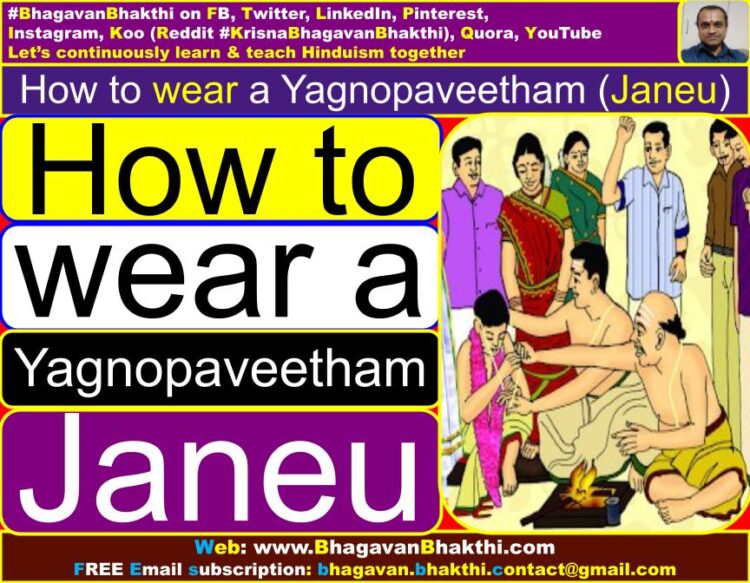
How to wear a Yagnopaveetham (Janeu) : ‘Yagnopaveetha Dhaarana Vidhi’ (way of wearing a Yagnopaveetham) is as given below:
1. We need to face the ‘purva dikh’ (east direction) or ‘uttara dikh’ (north direction). 2. Need to Perform Aachamanam. 3. Ganapati Dhyanam.
वक्रतुंद महाकाय कोटि सूर्या समरप्रभ, निर्विघ्नम कुरुमेदव सर्वकार्येषु सर्वदा ||
ವಕ್ರತುಂಡ ಮಹಾಕಾಯ ಕೋಟಿ ಸೂರ್ಯ ಸಮರ್ಪ್ರಭ, ನಿರ್ವಿಘ್ನಮ್ ಕುರುಮೇದೇವ ಸರ್ವಕಾರ್ಯೇಷು ಸರ್ವದಾ ।।
vakratuṇḍa mahākāya kōṭi sūrya samarprabha, nirvighnam kurumēdēva sarvakāryēṣu sarvadā।।
4. Bhagavan Sri Maha Vishnu’s dhyanam (meditate Bhagavan Sri Maha Vishnu)
शुक्लाम्बरधरम् विष्णुम शशिवरानं चतुर्भुजम्, प्रसन्न वदनम ध्यायेत सर्व विगणोप शान्तये ।।
ಶುಕ್ಲಾಮ್ಭರಧರಂ ವಿಷ್ಣುಮ್ ಶಶಿವರಣಂ ಚತುರ್ಭುಜಂ, ಪ್ರಸೇನ ವದನಂ ಧ್ಯಾಯೇತ್ ಸರ್ವ ವಿಘ್ನೋಪ ಶಾಂತಯೇ ।।
Śuklāmbharadharaṁ viṣṇum śaśivaraṇaṁ caturbhujaṁ, prasēna vadanaṁ dhyāyēt sarva vighnōpa śāntayē।।
After chanting this shloka, we need to do Pranamam (namaste) (prostration)!
Doing Sankalpam : ‘evam guna visheshana vishistayaam subha thithau, mama shrouta smartha vidhi vihita nitya karma sadachara anushtaana yogyataasiddhyartham (jaata/mrutaasoucha janita prayaschittartham) brahma tejobhivrudhyartham yagnopaveeta dhaaranam karishye.’
A new Yagnopaveetham (Janeu) must be purified with jala / water and haridraa / haldi / turmeric powder.
We need to invoke the presiding deities of Yagnopaveetham (Janeu), that is, Goddess Sri Gayatri Devi and Lord Sri Surya Deva.
yagnopaveetham – ithi mantrasya | parabrahma rishih (touch your forehead) | trushtup chandah (touch your below nose) | paramaatma devata (touch your chest) | yagnopaveetha dhaarana viniyogah |
Now, wear Yagnopaveetham one by one reciting the following mantra:
While we are wearing the Yagnopaveetham, it should be held by both hands, the knot in the Yagnopaveetham being held above by the right hand facing upwards:
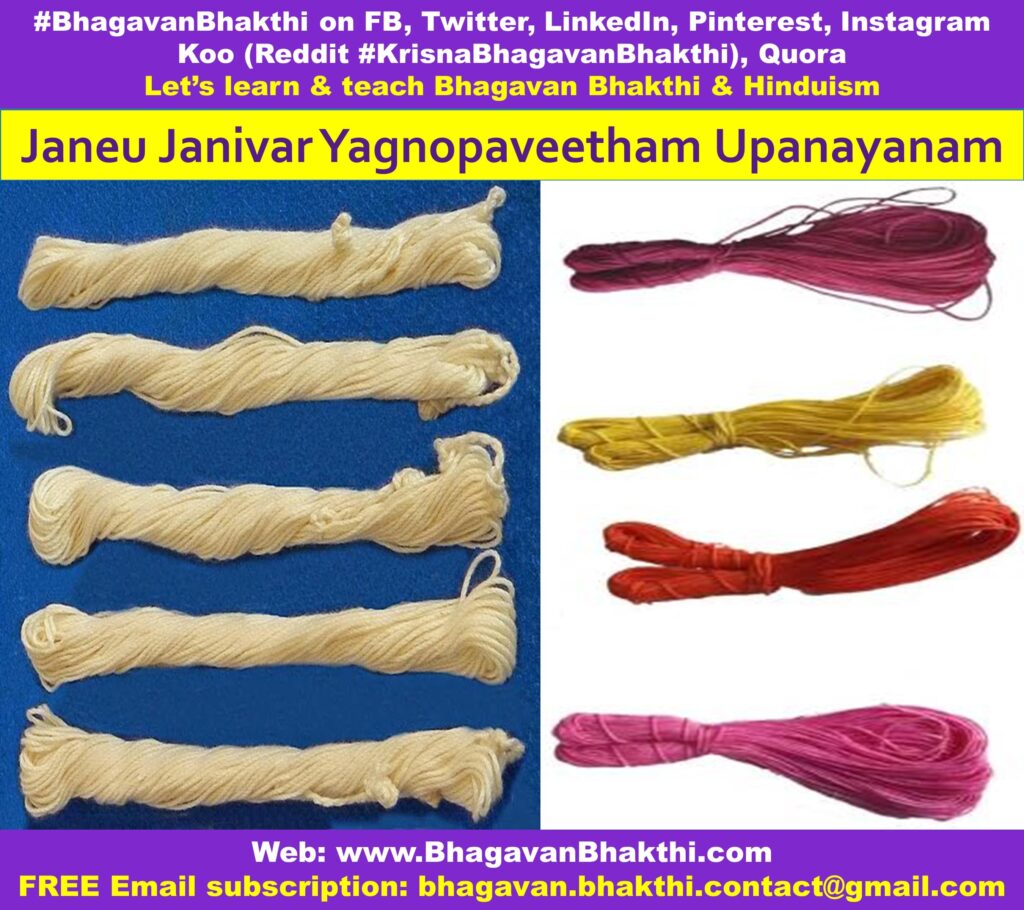
Yagnopaveetham dharana (wearing) Mantra is as given below:
परमं पवित्रं | यज्ञोपवीतं परमं पवित्रं प्रजापतेर्यत्सहजं पुरस्तात् | आयुष्यमग्र्यं प्रतिमुञ्च शुभ्रं यज्ञोपवीतं बलमस्तु तेजः ||
नवभिस्तन्तुभिर्युक्तं त्रिगुणं देवतामयम् | उपवीतं मया दत्तं गृहाण गणनायक ||
ಪರಮಂ ಪವಿತ್ರಂ | ಯಜ್ಞೋಪವೀತಂ ಪರಮಂ ಪವಿತ್ರಂ ಪ್ರಜಾಪತೇರ್ಯತ್ಸಹಜಂ ಪುರಸ್ತಾತ್ | ಆಯುಷ್ಯಮಗ್ರ್ಯಾಂ ಪ್ರತಿಮುಂಚ ಶುಭ್ರಂ ಯಜ್ಞೋಪವೀತಂ ಬಲಮಸ್ತು ತೇಜಃ ||
ನವಭಿಸ್ತಂತುಭಿರ್ಯುಕ್ತಂ ತ್ರಿಗುಣಂ ದೇವತಾಮಯಮ್ | ಉಪವೀತಂ ಮಯಾ ದತ್ತಂ ಗೃಹಣ ಗಣನಾಯಕ ||
Paramaṁ pavitraṁ | yajñōpavītaṁ paramaṁ pavitraṁ prajāpatēryatsahajaṁ purastāt | āyuṣyamagryāṁ pratimun̄ca śubhraṁ yajñōpavītaṁ balamastu tējaḥ ||
navabhistantubhiryuktaṁ triguṇaṁ dēvatāmayam | upavītaṁ mayā dattaṁ gr̥haṇa gaṇanāyaka ||
If in the case of a Brahmachari (unmarried male), one Yagnopaveetham (Janeu) is prescribed.
Grihastha (married male) should wear a second one after reciting the sankalpa as:
“mama grihasthasrama yogyataa siddhyartham dviteeya yagnopaveetha dhaaranam karishye”.
Similarly Grihastha should wear a third one with the sankalpa as:
‘mama Uttareeyartham’ and then recite once again the above mantra.
Yagnopaveetham (Janeu) should be worn one by one as said above and every time aachamanam should be performed and Gayatri mantra should be recited.
We should remove the old Yagnopaveetham (Janeu) from below the navel by reciting the following sloka:
य़ज्ञोपवीतं विसर्जन मन्त्रं | य़ज्ञोपवीतं छिन्नतन्तुं जीर्णकश्मल दूषितं | आयुर्वर्चो यशो बलाभि व्रुध्यर्थं जीर्णोपवीतं विस्रुजामि तेजः ||
ಯಜ್ಞೋಪವೀತಂ ವಿಸರ್ಜನ ಮಂತ್ರಂ | ಯಜ್ಞೋಪವೀತಂ ಛಿನ್ನತಂತುಂ ಜೀರ್ಣಕಶ್ಮಲ ದೂಷಿತಂ | ಆಯುರ್ವರ್ಚೋ ಯಶೋ ಬಲಾಭಿ ವೃದ್ಧಾರ್ಥಂ ಜೀರ್ಣೋಪವೀತಂ ವಿಸ್ರುಜಾಮಿ ತೇಜಃ ||
Yajñōpavītaṁ visarjana mantraṁ | yajñōpavītaṁ chinnatantuṁ jīrṇakaśmala dūṣitaṁ | āyurvarcō yaśō balābhi vr̥d’dhārthaṁ jīrṇōpavītaṁ visrujāmi tējaḥ ||
The old Yagnopaveetham (Janeu) should be dropped into water or on a tree and should not be thrown into a garbage.
Now again we need to perform aachamanam: We need to recite Gayatri Mantra as per ones capacity (10/100/1000).
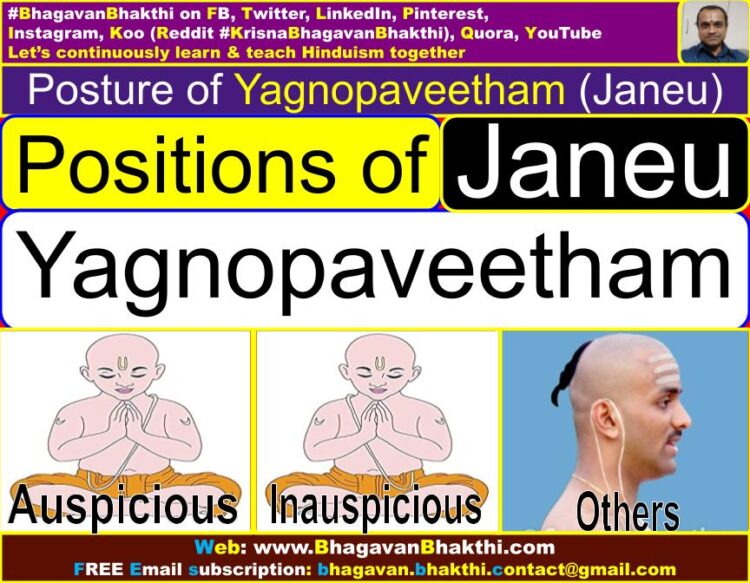
Posture (position) of Yagnopaveetham (Janeu) : The three postures (positions) of wearing of Yagnopaveetham (Janeu) are:
One is ‘upavita’ where the yagnopavita (Janeu) is worn over the left shoulder and under the right arm.
This posture is used for performing auspicious ceremonies and sacred rituals related to Gods. This is called ‘Savya’ position.
The second one is ‘praachinavita’, where the Yagnopavita (Jeneu) is worn above the right shoulder and under the left arm. This position is used while performing sacred rites to the pitrus / forefathers (pitru karyas). This is called ‘apasavya’ position.
Thirdly, when the yagnopavita (Janeu) is worn around the neck and over the chest in ‘maalakara’ (like garland) and is held with both thumbs in the region of the heart and above the naval, it is called ‘nivita’.
This form is used during ‘rishi tarpana’, sexual intercourse, answering nature calls, carrying a corpse etc.
We would have observed Brahmanas (Brahmins) tie tightly their Yagnopaveetham (Janeu) to the right ear / left ear while attending nature calls.
While it is to protect the sacred thread becoming soiled during the course of attending nature calls. There is also a health element involved in it.
It is said that important nerves connecting the excretory system pass through right / left ear. When pressure is applied, it helps in regulating the functioning of excretory organs. This is a type of Acupressure.
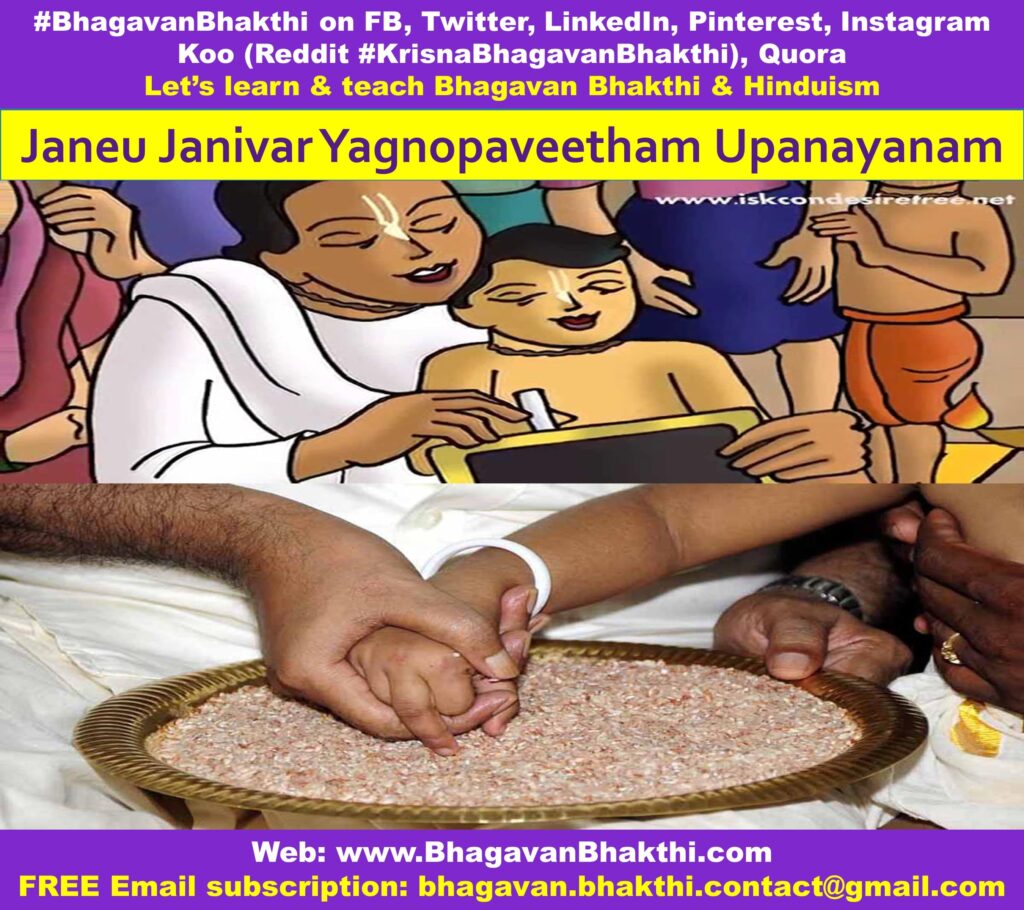
When to change Yagnopaveetham (Janeu) : Usually, when once a person starts wearing Yagnopaveetham (Janeu), generally it should not be removed and it should be worn always (24 hours and 365 days). It is like a woman wearing a ‘mangala sutra’ for ever.
But in practice it is not possible to wear the same Yagnopaveetham (Janeu) permanently.
This could be because of wear and tear, it may get soiled or worn out or gets broken and needs to be changed regularly as requirement. We should not wear a broken or worn out Yagnopaveetham (Jeneu).
Apart from this Yagnopaveetham (Janeu) should be changed under the following circumstances:
1. On the day of ‘upakarma’ that falls in Shravana maasam once in a year.
2. Whenever there is ‘jaata-soucham’ or ‘mrita-soucham’ (birth / death in the family).
3. Whenever one visits the danahagraha / shava samskraara gruha / cremation ground, or touches a shava / corpse.
4. Whenever one happen to touch a woman during her monthly periods.
Whenever there is a need to change Yagnopaveetham (Janeu), it should not be removed recklessly.
It should be changed first and then the worn out to be removed as per the laid down as per the correct procedure.
Yagnopaveetham (Janeu) colour : As per the scriptures, it is said that the sacred thread Yagnopaveetham (Janeu) should be white in color for Brahmanas (Brahmins), red in color for Kshatriyas and yellow in color for Vaishyas.
But in practice we find people using Yagnopaveetham which is white in color.
Yagnopaveetham (Janeu) quality : As per the scriptures, it is said that the sacred thread Yagnopaveetham (Janeu) should be made using cotton for Brahmanas (Brahmins), silk for Kshatriyas and linen for Vaishyas.
But in practice we find people using Yagnopaveetham (Janeu) made from cotton.
Yagnopaveetham composition : It is said that Yagnopaveetham (Janeu) is made up of nine layers of woven cotton thread spun by a virgin girl and twisted by a Brahmana (Brahmin) reciting the great ‘Gayatri mantra’ on an auspicious day.
(यज्ञोपवीतं नवतन्तु निर्मितं | ಯಜ್ಞೋಪವೀತಂ ನವತಂತು ನಿರ್ಮಿತಂ | Yajñōpavītaṁ navatantu nirmitaṁ |)
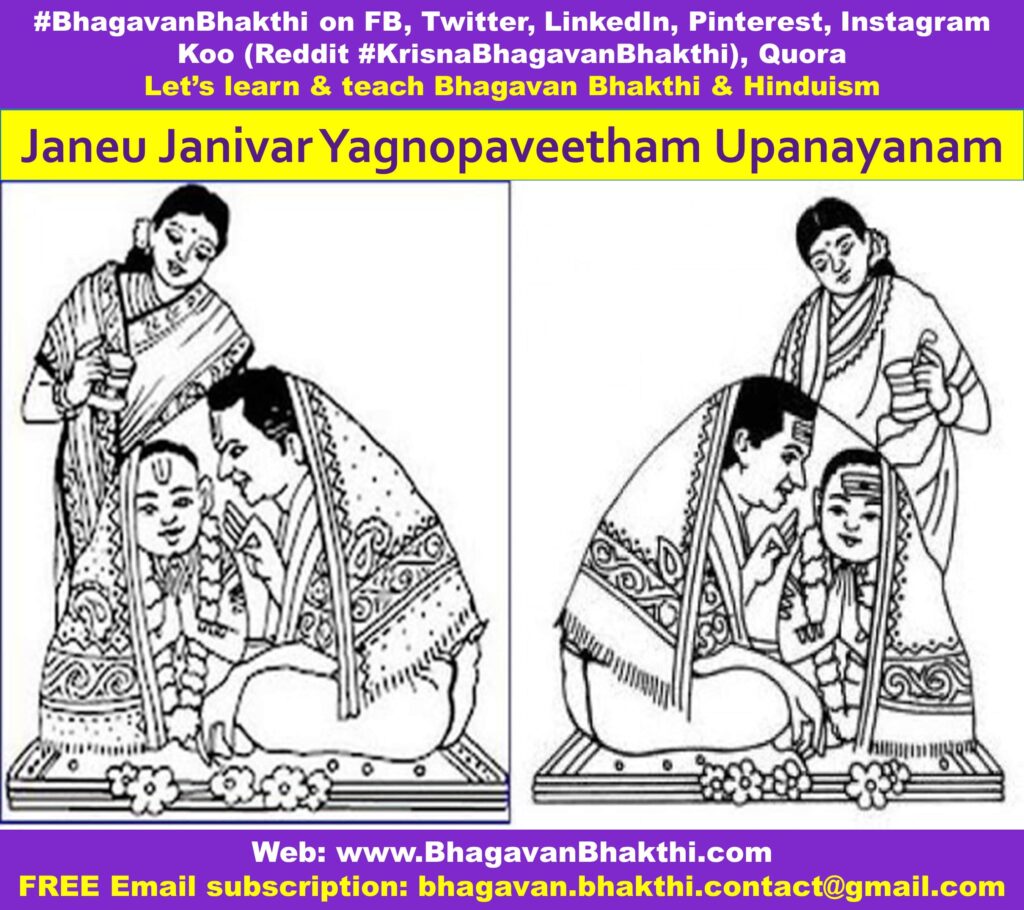
Meaning of arithmetic of number 96 in Yagnopaveetham (Janeu) : It is said that ‘Gayatri Mantra’ has 24 letters, and when it is added together from four Vedas it becomes 96 (24×4).
This gives the power or eligibility to a ‘Dvija’ to perform Yagna or Yagas and to recite Gayatri Mantra.
Four fingers represent the four states of the soul a man experiences from time to time (waking, dreaming, dreamless sleep, and absolute Brahmin-hood).
There is another arithmetic to this number, that is, a human body comprises of 25 elements made up of three Gunas (Satva, Rajo, Tamo).
We have 16 tithis (days) in our Panchanga / calendar, 27 Stars in the almanac, 4 Vedas, 6 Rutus (Ritus) in three Seasons (summer, winter and monsoon), and 12 months.
When all these are added together (25+3+16+27+4+6 +3+12) it comes to 96. It is said that a human life rotates around these elements.
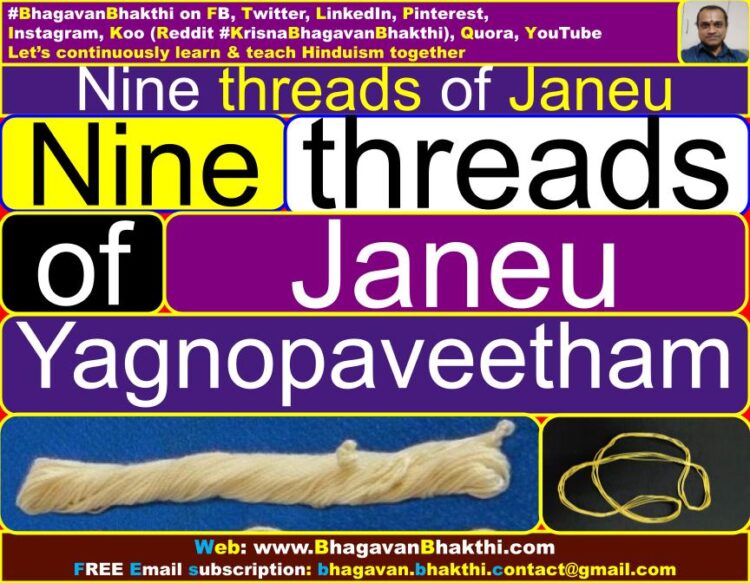
Significance of Nine layers (threads) in Yagnopaveetham (Janeu) : It is said that nine layers (threads) represent nine Devatas (Demigods). These Devatas (Demigods) who are the presiding deities of Yagnopaveetham (Janeu).
Nine Devatas (Demigods) names are : Pranavam (Omkara), Agni, Anantaa (Naga), Moon (Soma), Pitru Devatas, Prajapati, Vayu, Surya, and all other Devatas (Demigods).
It is said that before wearing the Yagnopaveetham (Janeu), one should offer prayer to all these nine deities.
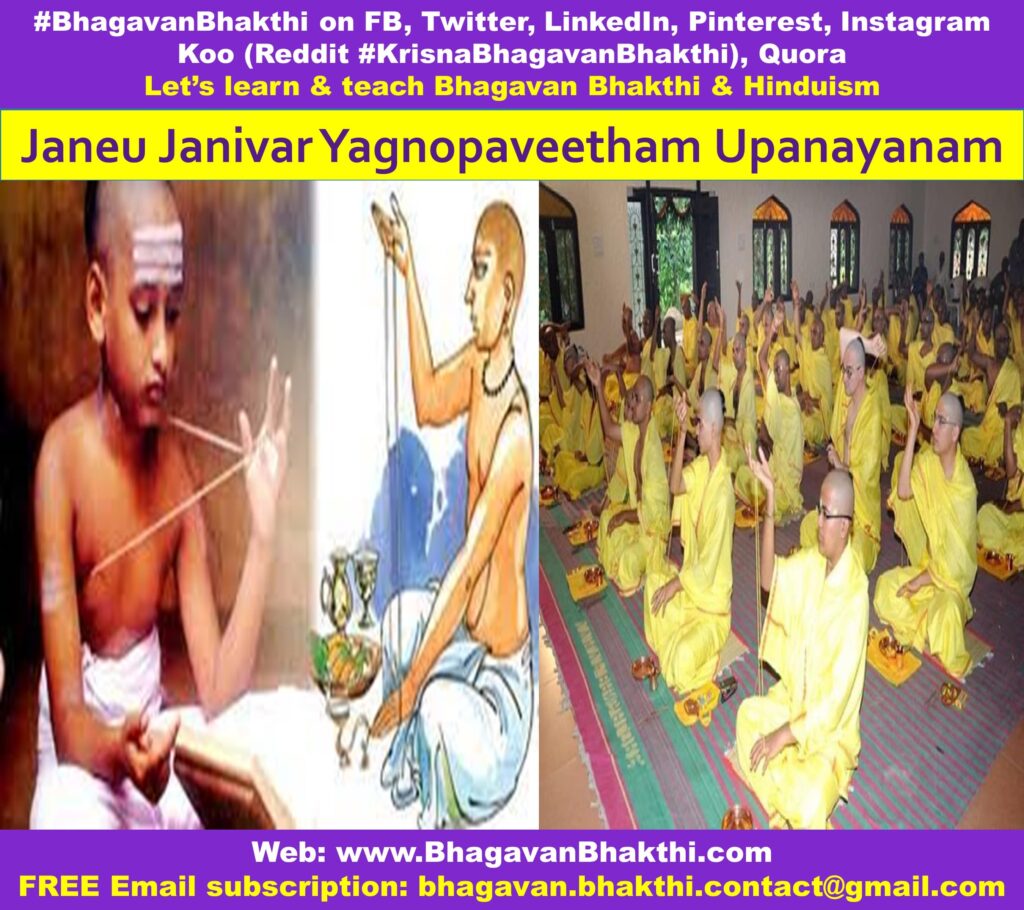
Brahma Granthi (Knot) : As per the scriptures (Hindu Texts), it is prescribed that the Yagnopaveetham (Janeu) should have knots equivalent to the number of Pravaras in one’s Gotra. But in practice we find only one knot (granthi) for the Yagnopaveetham (Janeu).
The knot (granthi) with which the three strands are tied together is called ‘Brahma Granthi’. This signifies the ParaBrahma (Pranavam) who is ‘sakala Veda Swaroopa’ (All Vedas forms), that is, Lord Sri Vishnu.
There are many interpretations about the three strands of Yagnopaveetham (Janeu).
It symbolizes the three Lords (that is, Brahma, Vishnu and Maheswara) when tied together it becomes ‘Para Brahma’, three worlds (Bhu, Bhuvar, Suvar), three feminine energies (Lakshmi, Sarasvati and Durga / Parvati), and three tattvas or qualities (Satva, Rajo, Tamo).
It is also interpreted as three strands representing Ida, Pingala and Sushumna naadi, through which the kundalini energy manifests as prana and consciousness.
The three strands also indicate that one who wears it should have a triple control over his mind speech and body (thought, word and deed).
Dvija information (meaning) : Dvija mean (dvi + ja = twice + born) twice born.
There is no difference between one child and another at the time of birth. All are born out of the mother’s womb only. This is the first stage of life (Shudra).
The second stage is getting the upadesha of ‘Gayatri mantra’ at the time of Upanayanam / Upanayana, that is, when the boy becomes a Dvija or twice-born. He is then purified.
The third stage is Vipra, when one has mastered the study of all the Vedas.
The fourth stage is Brahmana (Brahmin) when he actually realizes the original Brahman (Lord Sri Vishnu) through the knowledge of the Self.
Can one become Brahmana (Brahmin) by birth : One becomes a Brahmana (Brahmin) not by birth, but only when one he realizes the ‘Supreme Brahman’, that is, Lord Sri Vishnu. One becomes a Brahmana (Brahmin) by action and not by birth.
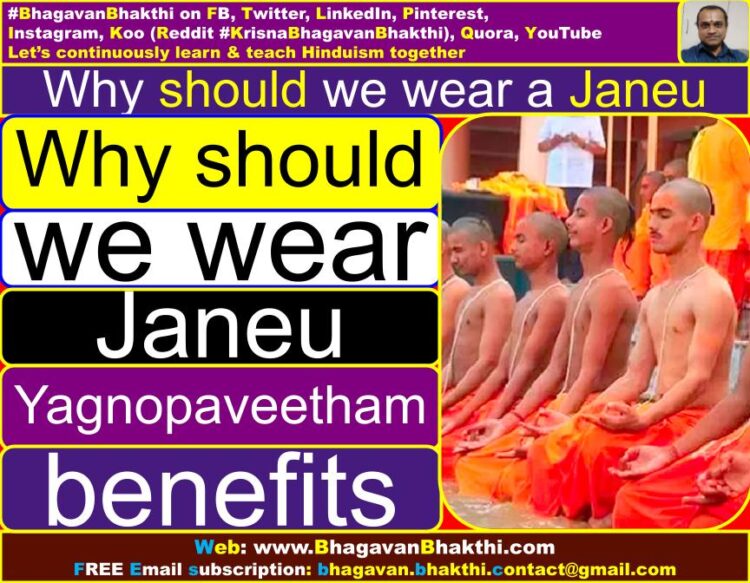
Why should we wear a Yagnopaveetham (Janeu) (benefits) : Wearing Yagnopaveetham (Janeu), will increase longevity of the person who wears it and gives physical and mental strength through the worship of Lord Sri Surya Deva using Gayatri Mantra for which one would have been initiated during his Upanayanam.
By wearing Yagnopaveetham (Janeu) one gets purified both externally and internally.
By wearing Yagnopaveetham (Janeu) one gets eligibility to perform spiritual and sacred rituals (Srouta / Smarta Karmas) as prescribed in Vedas for his Varna.
Sacred rituals performed by wearing Yagnopaveetham (Janeu) give good, better and best results.
vinayagnopaveethenaa bhojanam kurte dvijam | ajamutrapureershena retassevanamevacha!!
It is said that, one should not attend to nature calls, eating food, participate in sensual pleasures without Yagnopaveetham (Janeu). It is a prerequisite for learning Vedas and also for marriage.
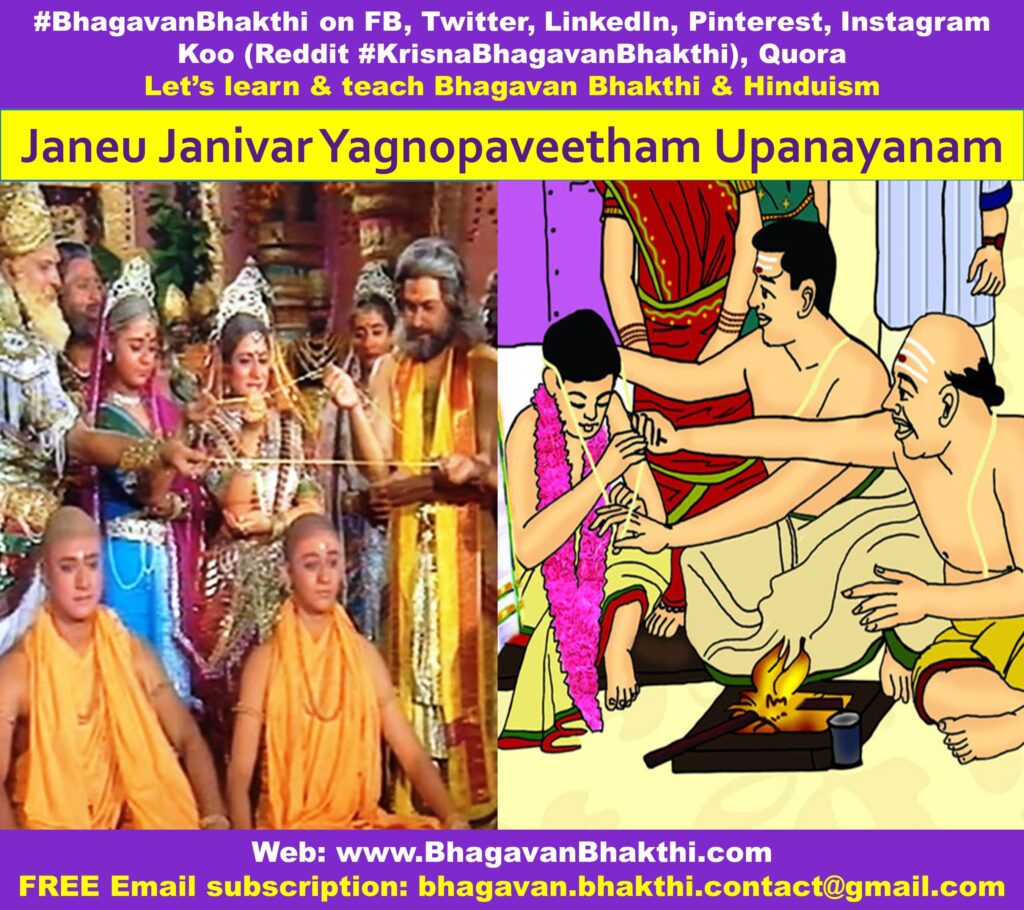
Yagnopaveetham (Janeu) significance and importance is as given below:
The Vedic (Vaidika) connection that a child lost when the umbilical cord is cut is re-established in the form of Yagnopaveetham (Janeu).
Means, in other words, Yagnopaveetham (Janeu) serves as an umbilical cord that connects him, not just his immediate parents, not just the three generations, but the entire tree of generations and the Rishi on whose root the whole tree flourished.
The three strands (threads) remind the wearer that he has to pay off the three debts (Runas) (Rins) (ऋण) he owes to the ancient seers, ancestors, and to the Gods (Rishi Runa, Pitru Runa, and Daiva Runa).
Yagnopaveetham (Janeu) is not a mere symbol to identify a community. One who wears a Yagnopaveetham (Janeu) may not necessarily be a Brahmana (Brahmin) and one who does not wear a Yagnopaveetham (Janeu) may not be a non-Brahmana (non-Brahmin) either.
Yagnopaveetham (Janeu) has the sanctity of its own and one has to qualify himself for wearing it, not just by birth alone but also by practice.
He alone is a Brahmana (Brahmin) who does his ‘nitya karma’ (daily rituals), follows the path of Sanatana Dharma and remains free from ego, avarice, anger and pride.
Uses of a wearing Yagnopaveetham (Janeu) (for the one whom the world knows as a Brahmin) are as given below:
Yagnopaveetham (Janeu) is not something that is worn for the world to know. It is for the realization of Surpeme Brahman (Lord Sri Vishnu) within.
But one who has thrown away his Yagnopaveetham (Janeu), but has led a life of truth is nobler compared to the one who wears his Yagnopaveetham (Janeu) but does nothing to justify it is also incorrect.
Also, one who wears the Yagnopaveetham (Janeu) and doesn’t performs his duties as per his varna, then also it is incorrect.
Both are very important. That is, wearing Yagnopaveetham (Janeu) is also important and also we need to perform our daily duties and rituals as per our varna.
Yagnopaveetham (Janeu) is a passport to obtain Vedic education. Yagnopaveetham (Janeu) is the mark of formal entry into Brahmin-hood.
Yagnopaveetham (Janeu) gives the power and authority to pursue his spiritual path.

Festival (utsavam) related to Yagnopaveetham (Janeu) is as given below:
Every year in the month of Shravana masam (month), which generally comes in the month of August during rainy season on the Purnima tithi (Full moon day) is the festival related to Yagnopaveetham (Janeu) and it is celebrated as called Upakarma.
Some times, it could fall on a day prior to or after the Purnima (Full moon day). It is not just simply a festival to celebrate and enjoy.
It is an occasion to make us remember the significance of Yagnopaveetham (Janeu) and Gayatri Mantra that has been initiated at the time of Upanayanam and rededicate ourselves to the spiritual path.
On this day, all those who have been initiated into the concept of Upanayanam change their Yagnopaveetham (Janeu) and wear a new one.
Continue reading about Hinduism (Sanatana Dharma) :
Hindu festivals information, significance, importance, etc.
Maharishi information, facts, importance, significance, etc.
Rivers information in Hinduism (Sanatana Dharma)
Hinduism (Sanatana Dharma) information, facts, etc.
Mahabharata information, facts, significance, importance etc.
Ramayana information, facts, significance, importance, etc.
More information will be added to his post (article) on regular basis. Please visit again to know the updated information after some time.
To watch videos on #Hinduism #Sanskrit language, SUBSCRIBE to my YouTube channel from this below link:
#BhagavanBhakthi YouTube channel
To know more about “Lord Sri Vishnu stories, information, facts, significances, etc.“, please click the below link:
Lord Sri Vishnu stories, information, facts, significances, etc.
Dear friends, if you need any clarifications about this post, kindly let me know, I will definitely try to answer all of them.
Also your one LIKE, one COMMENT, One Share, one SUBSCRIPTION is highly important.
This will help to know the quality of this content and also it will be helpful to know if any improvements is required for the content.
If you feel this content is useful to you and has helped you to improve your knowledge, kindly share this with your well-wishers.
Because “SHARING MEANS CARING”.
For receive FREE EMAIL SUBSCRIPTION about #BhagavanBhakthi, you can send an email to bhagavan.bhakthi.contact@gmail.com from your email ID.
NAMASTE!
SRI GURUBHYO NAMAHA
OM NAMO NARAYANAYA
Sri Krishnaarpanamastu
Share in Social Media
I’m really inspired with your writing abilities as smartly as with the structure in your blog.
Good day! This post could not be written any better!
Reading this post reminds me of my old room mate!
He always kept talking about this. I will forward this
page to him. Pretty sure he will have a good read.
Thanks you for sharing!